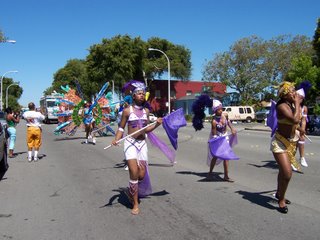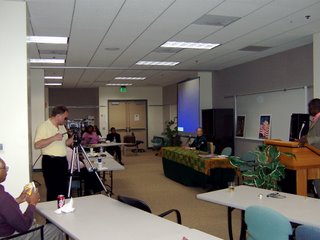 The day of divine madness and a blinding epiphany!
The day of divine madness and a blinding epiphany!Today's trip brought us past infamous, trash-ridden, needle-infested Fourth Street park on lower Macdonald Avenue. It's a carbon copy of areas in many parts of the country where those lost to the system find fellowship and the next fix or -- on a lucky day -- divine guidance from some itinerant street preacher. It's the kind of an area that the "good folks" avoid if at all possible - and that (I suspect) most city's tolerate and rarely rehabilitate since they are a dependable magnet for state and federal grants -- money that finds its way into the city's general fund to be used for other pressing civic needs. Such a magnet serves the general good, I suppose, since they tend to serve as make-work for a steady stream of professionals; social workers, drug counselors, grants writers, and a host of others whose career path is secured so long as we continue to see those tragic lives as criminal rather than needing to be looked at as problems of public health or a failed system of public education. So much for the sermon.
What lower Macdonald Avenue reminded me of today was the area of South Berkeley in the 70s and 80s when this might well have described Sacramento Street -- the location of Reid's, our small music store. The street was alive day and night with drug dealers on every corner using bus stops as offices; hookers and gamblers using easily detectible floating games working out of parked vans and trailers along the street. There was surely life on the streets, and we were right in the middle of it. The area was considered so risky that no company would insure our building or its contents.
It was during that time that I was working part time in the shop while also holding a job as the Aide for a member of the Berkeley City Council.
My friend, Joan, had recently returned from Washington, D.C., where she had served as the director of the African Institute -- after serving as head of the State Department Reception Center at the Federal Building in San Francisco -- appointed by President Jimmy Carter. Joan grew up in Berkeley -- her stepmother, Zola, and I worked together at Boilmaker's A-36 during the war.
It was Joan who originated the "Just Say No" campaign with the support of First Lady Nancy Reagan. She'd been hailed as a leader in drug prevention from the nation's capital, and was now going to open a small program in South Berkeley. That program would be housed in a corner office in my Sacramento Street building and would serve the at-risk children of the community.
The little office was painted and spruced up with new office furniture and a small staff hired. We planned a Grand Opening to be held on a Saturday afternoon, and I placed all of the information in my talking windows announcing the event.
I knew that (just as the "good folks" avoid Macdonald Avenue these days for the same reasons), the city dignitaries would surely feel insecure coming to South Berkeley where the streets were so filled with poor, troubled, young and not so young, sinners and idlers with little to do and nowhere else to go.
Answer: With the help of some neighbor children, I made up and personally signed colorful hand-crafted construction paper invitations and went out along a five block commercial strip where the street people socialized on the corners and in the doorways. I handed out invitations to everybody on the street, telling them about the party and warmly inviting each to be sure to come! That was midweek. I'd had a slow start, but by that time I'd become very much a business leader in the community and lived under the protection of the street people and the young drug dealers.
When Saturday morning came the street was strangely quiet. Shortly after noon Joan's office staff began to prepare the cookies and punch, inflate the balloons, and drape the streamers. The party was set for two o'clock. At about that time the "uptown" guests began to arrive. The streets were still absolutely empty. No one stood on the usually busy corners. Nobody lay in the doorways or gathered tossing pennies for gain. Street-trading had come to a standstill. The entire community was at home getting ready for the party! And by 2:30 as the mayor and councilmembers and other dignitaries began to arrive, the community began to pour into our little offices. They were dressed for church with kids with starched dresses and shirts -- little girls with lace-topped bobbysox over black patent leather shoes, with neatly-braided hairdos and faces shining from the last minute rub-on of Vaseline. There were ladies in hats and young men in suits and ... no one on the streets! Even the most derelict had sobered and gussied up for the party!
It was clear that someone had appointed him or herself the organizer and word had spread that Miss Betty was having a party and everybody better damned well get off the street!
At one point during the festivities -- I brought Mayor Loni Hancock out to the curb for a look up and down the street. It was a miracle. Nothing we'd seen or heard at those frequent meetings of community leaders and police -- nothing we'd suffered through while seeking answers to the social problems of South Berkeley -- nothing had prepared us for this deceptively simplistic answer to the dilemma of crime and "street loitering."
Was it simply that no one had ever thought to invite everybody to the party?
It couldn't be that easy, but doesn't it make you wonder?
Photo: on Saturday we celebrated "Juneteenth," (a Texas holiday) with a parade down Macdonald Avenue and a picnic in Nicholl Park. There were many months before news of the Emancipation Proclamation reached Texas -- June 19th, 1865, was that day. This holiday is celebrated across the nation, now, in African American communities everywhere. Made me wonder why there has never been a national holiday declared for the Emancipation Proclamation, anyway? Maybe it wouldn't past muster in the southern states, I suppose. Right.


